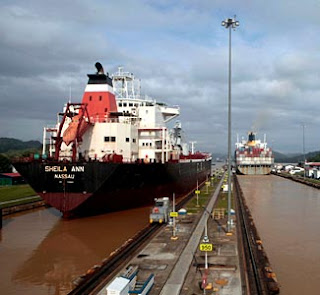
Decoding Trump’s Infrastructure Vision: Lessons from Engineering Marvels Like the Panama Canal
When we talk about America’s future, we often envision gleaming new highways, modernized airports, and robust public transit systems. President Trump’s ambitious infrastructure vision aimed to do just that – to usher in a “golden age” of construction and rebuild America’s public works. But to truly understand the potential and pitfalls of such a grand undertaking, it’s worth looking back at some of history’s most audacious engineering feats. The Panama Canal, a testament to human ingenuity and perseverance, offers profound lessons that can illuminate our path forward in rebuilding America.
The Grand Ambition: Trump’s Infrastructure Push
President Trump’s legislative outlines consistently emphasized the need to rebuild and reinvest in the nation’s infrastructure. The core of this vision was to stimulate economic growth through “shovel-ready projects” and modernize public works across the country. This wasn’t just about fixing potholes; it was about a comprehensive approach to revitalizing America’s physical backbone.
The administration sought statutory changes to eliminate barriers that often hinder efficient project management and delivery. The goal was clear: to streamline processes and accelerate the development of vital infrastructure assets.
Key Pillars of Trump’s Vision:
- Modernization: Upgrading aging systems to meet 21st-century demands.
- Economic Stimulus: Creating jobs and fostering growth through large-scale construction.
- Regulatory Reform: Removing red tape to expedite project timelines.
- Public-Private Partnerships: Encouraging private sector investment to supplement public funding.
Lessons from the Isthmus: The Panama Canal’s Legacy
The Panama Canal, a true engineering marvel, stands as a powerful symbol of what humanity can achieve when faced with immense challenges and driven by a clear objective. Its history is a rich tapestry of vision, struggle, and ultimately, triumph.
From Dream to Reality: The Canal’s Genesis
The idea of connecting the Atlantic and Pacific oceans across the narrow Isthmus of Panama dates back centuries. However, it was the monumental effort of the early 20th century that finally brought this dream to fruition. The French, led by Ferdinand de Lesseps, initially attempted the project but faced insurmountable obstacles, including disease and engineering complexities.
American Ingenuity and Overcoming Adversity
The United States took over the project in 1904. This phase was marked by significant advancements in engineering and a brutal, yet ultimately successful, public health campaign led by Dr. William Gorgas. His efforts to eradicate mosquito-borne diseases like malaria and yellow fever were critical to the project’s success, saving countless lives.
The construction itself was a feat of unparalleled scale. Millions of cubic yards of earth were excavated, enormous locks were built, and the challenging Culebra Cut (now the Gaillard Cut) was carved through the continental divide. This wasn’t just about building a waterway; it was about conquering nature’s formidable barriers.
Connecting the Dots: Trump’s Vision and the Canal’s Blueprint
When we look at the Panama Canal’s history through the lens of Trump’s infrastructure vision, several parallels and lessons emerge. The strategic value and global logistics implications of the canal are undeniable, shaping trade patterns for over a century.
Project Scale and Complexity
The Panama Canal was not a simple undertaking. It required immense capital investment, meticulous planning, and a workforce of tens of thousands. Similarly, any large-scale American infrastructure initiative, such as rebuilding highways or upgrading the electrical grid, demands similar levels of commitment and resources.
Overcoming Obstacles: Regulation and Red Tape
One of the recurring themes in discussions about Trump’s infrastructure plan was the need to streamline regulations. The Panama Canal’s construction was plagued by numerous bureaucratic and logistical hurdles. While the context is different, the principle of efficient project delivery remains the same. Removing unnecessary barriers can accelerate progress and reduce costs.
The Importance of Strategic Vision
The Panama Canal wasn’t just an engineering project; it was a strategic imperative for the United States, enhancing its naval power and economic reach. Trump’s vision also underscored the strategic importance of a modernized infrastructure for national security and economic competitiveness.
Public-Private Partnerships: A Modern Approach
While the Panama Canal was primarily a government-led endeavor, modern infrastructure development often relies on public-private partnerships. These collaborations can bring private sector efficiency and capital to large-scale projects. This was a key component of Trump’s proposals, aiming to leverage private investment for public good.
Operational Success: The Canal’s Enduring Value
The canal’s capacity upgrades over the years, including the expansion completed in 2016, demonstrate the importance of continuous investment and adaptation. This speaks to the need for long-term planning in American infrastructure projects, ensuring they remain relevant and functional for decades to come.
What Can We Learn? Key Takeaways for America’s Infrastructure
The story of the Panama Canal offers invaluable insights for anyone looking to decode Trump’s infrastructure vision. It’s a reminder that ambitious goals are achievable, but they require more than just ambition.
- Embrace Boldness, but Plan Meticulously: The canal’s success hinged on a bold vision, but also on detailed engineering and logistical planning. America’s infrastructure projects need both.
- Prioritize Public Health and Safety: Dr. Gorgas’s triumph over disease highlights the critical role of public health in large-scale projects. This translates to ensuring worker safety and environmental protection in modern construction.
- Streamline Processes, Not Sacrifice Standards: While cutting through red tape is crucial, it shouldn’t come at the expense of environmental stewardship or safety regulations. Finding the right balance is key.
- Invest for the Long Term: The Panama Canal’s enduring value is a testament to forward-thinking design and ongoing upgrades. Our infrastructure must be built with future generations in mind.
- Understand the Strategic Importance: Investing in infrastructure is not just an economic matter; it’s a strategic imperative for national security and global influence.
By studying engineering marvels like the Panama Canal, we gain a deeper appreciation for the complexities and potential of large-scale infrastructure development. Decoding Trump’s infrastructure vision involves recognizing the lessons from history and applying them to the challenges and opportunities of building a stronger, more resilient America.

Additional Information
Decoding Trump’s Infrastructure Vision: Lessons from Engineering Marvels Like the Panama Canal
Donald Trump’s repeated focus on infrastructure, particularly referencing the Panama Canal, offers a unique lens through which to analyze his vision for American public works. While his rhetoric has often been aspirational, drawing parallels to monumental achievements of the past, a deeper understanding requires examining the core principles and historical context that made feats like the Panama Canal successful. This analysis will delve into Trump’s infrastructure ambitions, drawing lessons from the engineering marvel that connects two oceans, to understand the potential for modernizing America’s public works and stimulating economic growth.
The Panama Canal: A Testament to Vision, Engineering, and Political Will
The Panama Canal stands as a towering achievement of human ingenuity and perseverance. Its construction, a complex endeavor fraught with engineering challenges, disease, and political hurdles, ultimately revolutionized global trade and connectivity. As highlighted by the Atlantic Council and CNN, the canal’s history is intrinsically linked to American involvement, from its conception and construction under U.S. direction to its eventual return to Panamanian control. This long and storied past underscores the canal’s enduring strategic value and its impact on global logistics, as noted by Shiplilly.
The canal’s success wasn’t solely about digging a ditch; it was a multifaceted undertaking that demanded:
- Grand Vision and Long-Term Planning: The dream of linking the Atlantic and Pacific predated American involvement, but it required a bold, long-term vision to overcome the formidable obstacles. This was a project that spanned decades and required sustained commitment across different administrations.
- Cutting-Edge Engineering and Innovation: The project pushed the boundaries of engineering, employing innovative techniques to conquer the challenging terrain and overcome landslides. The development of the lock system, in particular, was a groundbreaking solution to navigating the elevation changes.
- Significant Capital Investment and Funding: Building such a colossal structure necessitated massive financial resources, a testament to the perceived return on investment.
- Effective Project Management and Labor: The construction involved managing vast labor forces, often in arduous conditions, and required efficient coordination to maintain progress.
- Political Will and International Diplomacy: The project involved complex negotiations with Panama and navigating international relations to secure land and rights for construction and operation.
Trump’s Infrastructure Vision: Echoes of Past Ambition
President Trump’s infrastructure vision, as articulated in documents like the “Highlight of President Trump’s Legislative Outline for Infrastructure Improvements” from the Department of Transportation, centers on rebuilding and reinvesting in the nation’s infrastructure. Grassi Advisors suggests this approach has the “potential to usher in a golden age of construction that will modernize America’s public works and stimulate economic growth.” This ambition, while laudable, requires translating grand pronouncements into actionable plans.
Trump’s emphasis on “shovel-ready projects” and eliminating “barriers to efficient and effective management and delivery of infrastructure projects” signals an intent to streamline the process, a critical lesson learned from large-scale historical projects. The ISSF points out that Trump’s rhetoric around the Panama Canal also touches upon “power, sovereignty, and global infrastructure politics,” suggesting a broader geopolitical dimension to his infrastructure thinking.
Lessons for America’s Infrastructure Renaissance:
The Panama Canal serves as a powerful case study, offering crucial lessons for any endeavor to revitalize American infrastructure:
- The Need for a Clear and Sustained Vision: Like the canal, a modern infrastructure overhaul requires a clear, overarching vision that transcends political cycles. It needs to articulate not just what needs to be built, but why and how it will benefit generations to come. Trump’s focus on the canal, while potentially strategic or symbolic, needs to be backed by a concrete, long-term domestic infrastructure plan.
- Embracing Innovation and Engineering Excellence: America has a rich history of engineering innovation. Modern infrastructure projects should leverage the latest technologies in design, construction, and materials to ensure durability, efficiency, and sustainability. This means investing in research and development within the engineering and construction sectors.
- Prioritizing Smart Investment and Funding Mechanisms: The scale of the Panama Canal’s construction underscores the necessity of significant and reliable funding. Identifying sustainable funding models, whether through public-private partnerships, user fees, or targeted federal investment, is paramount. The “funded shovel-ready projects” aspect of Trump’s vision is a starting point, but a robust, long-term funding strategy is essential.
- Streamlining Regulatory Processes Without Sacrificing Standards: While Trump’s legislative outline aims to remove barriers, it’s crucial to strike a balance. The efficiency gained by cutting red tape should not come at the expense of environmental protection, safety regulations, or community input. The Panama Canal’s success involved navigating complex permitting and land-use issues, which, while challenging, were integral to its responsible execution.
- The Importance of Geopolitical and Economic Strategy: The Panama Canal’s impact extends far beyond its physical presence; it is a critical node in global trade. Similarly, America’s infrastructure investments should be strategically aligned with its economic and geopolitical goals, enhancing competitiveness and national security.
The Future of American Infrastructure:
Trump’s engagement with the idea of monumental infrastructure projects, exemplified by his references to the Panama Canal, highlights a desire for a significant national undertaking. However, the success of such a vision hinges on its ability to translate ambition into detailed planning, secure dedicated funding, foster engineering innovation, and maintain a consistent political commitment. By learning from the triumphs and challenges of engineering marvels like the Panama Canal, America can pave the way for a future where its infrastructure is not only modernized but also stands as a testament to enduring vision and execution. The ongoing discussions around the Panama Canal’s strategic value and Trump’s agenda, as highlighted by CNN and Shiplilly, underscore the enduring relevance of such mega-projects in shaping both national economies and international relations.






Leave a Reply